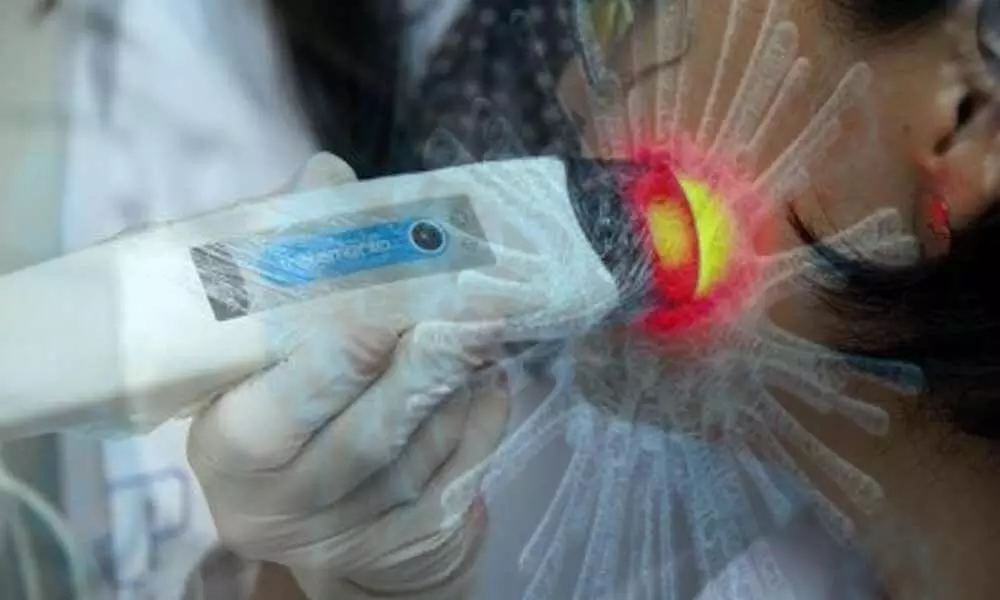Live
- Bail Granted to Six Accused in Allu Arjun Residence Attack Case
- Chief Minister Revanth Reddy Extends Best Wishes on Singareni Foundation Day
- Sukumar Hails Ram Charan's "National Award-Worthy" Performance in Shankar's 'Game Changer'
- CM Revanth Reddy to Hold Review Meeting with Senior Officials Today
- Pawan Kalyan's Visit to Penamaluru Constituency Today
- Kadapa Municipal Corporation Meeting: Heavy Police Deployment and Section 144 Imposed
- Mandhana, Renuka blow away Windies in first ODI
- Heavy rush for Bhavani Deeksha Viramana continues
- Steps taken to ensure accommodation to common devotees says TTD EO J Syamala Rao
- CRDA invites tenders for ‘Happy Nest’ township
Just In
This therapy can combat secondary infections in corona patients


For representational purpose
Rio de Janeiro: Photodynamic therapy can be an efficient ally to combat secondary infections in Covid-19 patients, according to a new study.
Rio de Janeiro: Photodynamic therapy can be an efficient ally to combat secondary infections in Covid-19 patients, according to a new study.
The use of this technique combines light and a photosensitizing chemical substance to kill microorganisms in the respiratory tract, the findings, published in the journal Photodiagnosis and Photodynamic Therapy, reported.
"Covid-19 can lead to complications that go beyond the virus, and we should also strive to find treatments for these other problems," said study researcher Vanderlei Bagnato from Optics and Photonics Research Center (CEPOF ) in Brazil.
"Treating coinfections and secondary infections can improve the prognosis in severe cases, above all for patients who are intubated and face a higher risk of infection by other microorganisms such as the bacteria that cause pneumonia," Bagnato added.
The compounds used in photodynamic therapy interact with light to produce singlet oxygen, a highly reactive oxygen species that kill viruses and bacteria by oxidizing their membranes.
"When the patient inhales these substances, the drug can be activated with extracorporeal light, which then attacks pathogens in the airways," Bagnato said.
Photodynamic therapy cannot be used to attack the novel coronavirus SARS-CoV-2 directly since it does not eliminate harmful microorganisms present in the bloodstream (only in the airways). However, researchers stress the importance of developing techniques to combat Covid-19 coinfections caused by bacteria and other viruses, avoid the need for intensive medical care, and minimize transmission of the disease to other people.
CEPOF has conducted several studies on the use of photodynamic therapy to treat pneumonia, skin cancer, and other diseases. "The propagation of opportunistic pathogens occurs mainly through the upper respiratory tract owing to natural colonization of the oropharynx and that photodynamic therapy can help not only to reduce the number of these microorganisms present in the oropharynx but also to prevent their penetration into the mucosal barrier and hence their proliferation," the authors wrote.
"We're about to begin a study to evaluate the use of photodynamic therapy in cases of pneumonia in pigs. This stage precedes clinical trials in humans," Bagnato said.
"We hope it will be fast-tracked because, although we don't know for sure yet, it's quite likely that people who survive COVID-19 may be more prone to respiratory complications such as pneumonia because of the severe inflammation," Bagnato added.
The research team said they need to develop novel techniques and alternative treatments.

© 2024 Hyderabad Media House Limited/The Hans India. All rights reserved. Powered by hocalwire.com






